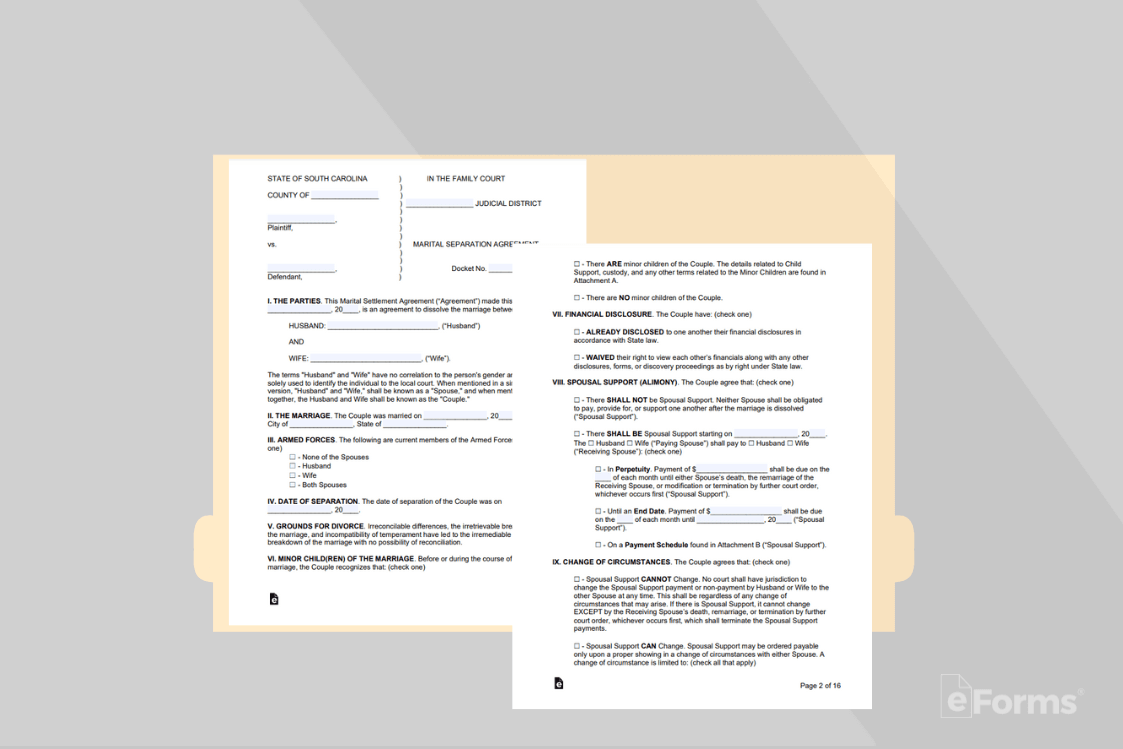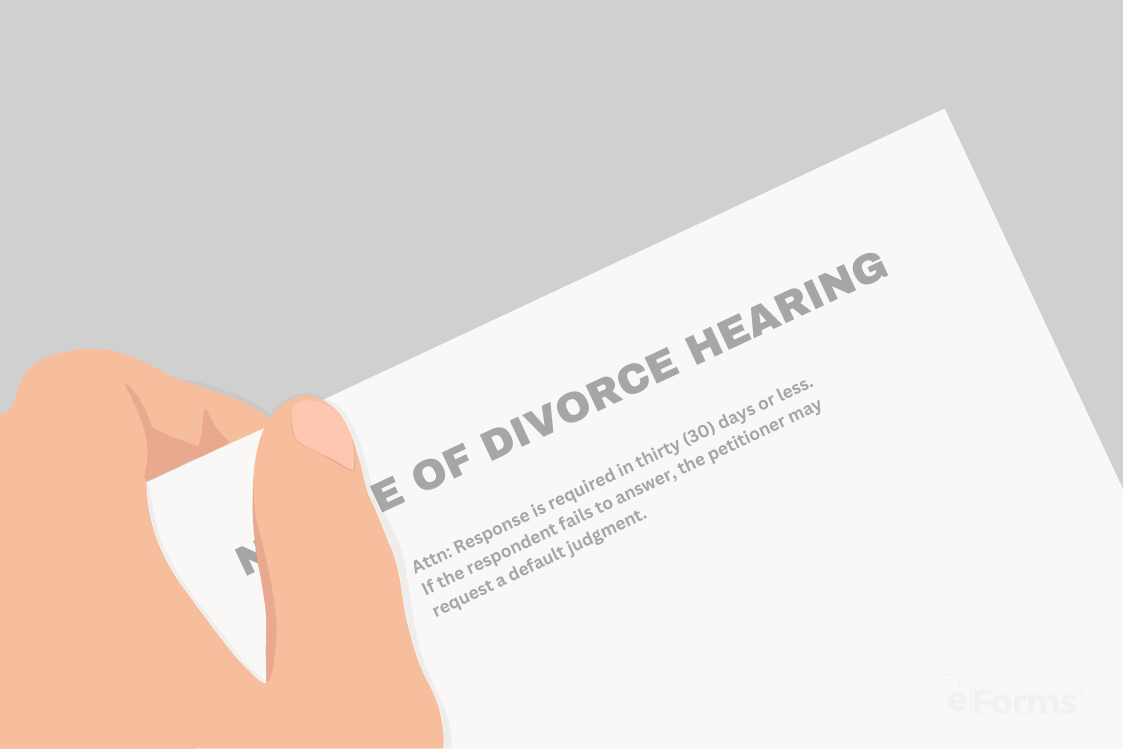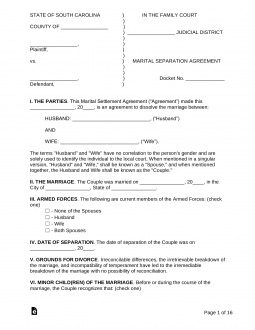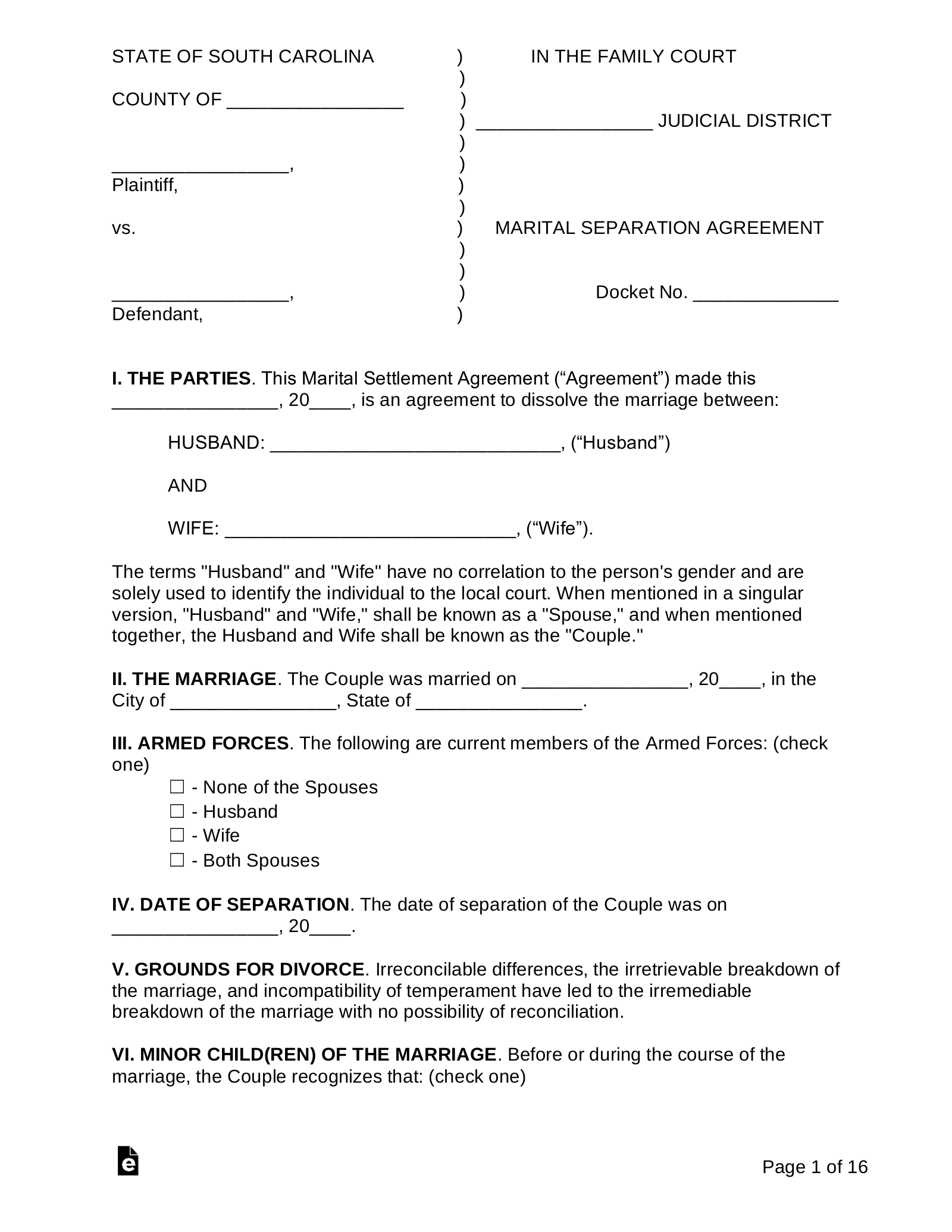Updated August 29, 2023
A South Carolina marital settlement agreement is a formal agreement made between two (2) spouses that determines certain terms and conditions of the couple’s divorce or separation. Issues covered in a settlement agreement include alimony payments, property and asset distribution, child support, and child custody and visitation rights. If the spouses are on good terms, it may be relatively quick and painless to come to a decision on all these matters and finalize the settlement agreement. However, it’s still recommended to seek legal counsel or mediation to help complete this important document. A settlement agreement should only be signed once all matters have been discussed and agreed upon, at which point the agreement becomes legally binding. This agreement alone is not recognized as an order for a divorce or legal separation, the spouses still have to file for a divorce with their local family court.
Table of Contents |
Divorce Laws
Statutes – Title 20, Chapter 3 (Divorce)
Alimony (§ 20-3-130) – Alimony may be awarded to either party by court order in the form of permanent, periodic, lump-sum, rehabilitative, reimbursement, or other form of spousal support. The court will consider a number of factors when determining a fair and reasonable alimony award to the supported spouse, including the following:
- Duration of the marriage and ages of the parties at the time of marriage and divorce
- Physical and emotional condition of the parties
- Educational background of the parties, and need for training/education to achieve income potential
- Employment history and earning potential of the parties
- Standard of living established during the marriage
- Current and anticipated earnings of the parties
- Marital and nonmarital properties
- Custody of children
- Marital misconduct or fault of either or both parties
- Potential tax consequences as a result of awarded support
- Obligations of support from a prior marriage
Alimony Calculator – McIlveen Family Law Firm
Child Support (§ 63-17-470 and S.C. Soc. Serv. Reg. 114-4710 to -4750) – When determining child support payments, the court will use the child support guidelines created by the Department of Social Services. These guidelines are created to establish the minimum contributions that must be applied by the courts in determining the amount the supporting spouse must pay. The court may deviate from these guidelines only if they can prove the application of these guidelines would be unjust or inappropriate in a particular case.
Child Support Calculator – Department of Social Services
Division of Property (§ 20-3-620) – Property of the marriage (“marital property”) shall be split equitably, as opposed to evenly, between the spouses in accordance with the equitable distribution law.
Grounds for Divorce (§ 20-3-10) – Spouses may petition for a divorce on any of the following grounds:
- Adultery
- Desertion for a period of at least one (1) year
- Physical cruelty
- Habitual drunkenness (including any narcotic drug)
- Separation without cohabitation for a period of one (1) year*
*This is the only grounds for divorce that is not fault-based.
Interim Support (§ 20-3-120) – Courts will almost always grant interim support requests (temporary alimony during the divorce proceedings) from either party as long as the claim is well-founded.
Residency (§ 20-3-30) – Either spouse (plaintiff or defendant) must have resided in the state of South Carolina for at least one (1) year prior to filing a divorce action. If both spouses have resided in the state, the plaintiff need only have resided in the state for three (3) months prior to filing the action.
Separation (§ 20-3-10(5)) – The only way to file a divorce action that is not fault-based (i.e., not on grounds of adultery, desertion, physical cruelty, or drunkenness) is if the spouses have been living separately and apart for a period of one (1) year or more.
Divorce Forms
Where to File – Family Court
How Long Does it Take? One (1) to two (2) months (minimum)
- Family Court Cover Sheet
- Certificate of Exemption
- Summons for Divorce
- Complaint for Divorce
- Financial Declaration Form (requires notarization)
- Affidavit of Service by Mailing
- Acceptance of Service
- Affidavit of Service
- Defendant’s Answer
- Request for Hearing
- Notice of Hearing (provided by Court Clerk)
- Affidavit of Service by Mailing (Notice of Hearing)
- Final Order of Divorce
- Report of Divorce or Annulment of Marriage
- Judgment in a Family Court Case
How to File for Divorce in South Carolina (6 steps)
- Separation
- Marital Settlement Agreement
- Complaint and Summons
- Service of Process
- Notice of Hearing
- Hearing
1. Separation
2. Marital Settlement Agreement

A Marital Settlement Agreement may be executed by the spouses before filing for divorce. This isn’t a mandatory court document; however, since both parties must agree to all issues in an uncontested divorce to obtain a divorce order from a judge, they may want to establish all the terms of the divorce in this agreement before filing the Complaint. A settlement agreement can be completed by the spouses alone, but it is recommended that legal counsel be sought or a mediator hired to aid in this process.
3. Complaint and Summons

When filing an uncontested divorce action, it doesn’t really matter which spouse files the initial paperwork. The filing party will be named the “plaintiff” and the non-filing party will become the “defendant,” simply for the purposes of the court proceedings. The first forms the plaintiff must download, complete, and file include the following documents, which can be used by spouses with or without children:
- Family Court Cover Sheet
- Certificate of Exemption
- Summons for Divorce
- Complaint for Divorce
- Financial Declaration Form (requires notarization)
If the plaintiff intends on resuming their former name after the divorce, they may include this request in the Complaint so the judge can approve it in the divorce order. Two (2) copies of the completed forms should be made, and the plaintiff must bring the originals and both copies to the family court clerk. The courthouse where the papers can be filed depends on the residency situation mentioned in Step 1. If the plaintiff has been a resident of the state for the appropriate time period, they may choose to file either in the county where they last shared a residence with their spouse, the county where their spouse currently lives, or the county in which they live (as long as the other spouse lives out of state). The clerk will charge a $150 filing fee and assign the case a docket number. The docket number will be entered on all documents, the originals will be kept by the clerk and the two copies returned to the plaintiff.
4. Service of Process
- U.S. Mail – The documents must be sent by certified mail, restricted delivery, return receipt requested. The return receipt card must be signed by the defendant. Once the plaintiff receives the receipt, they can record the docket number and write “Summons and Complaint” on the card and make a copy. The original receipt card must be filed with the court along with a signed Affidavit of Service by Mailing form, which must be signed by the plaintiff in the presence of a notary.
- Personal Service – This option can be used if the plaintiff knows the defendant will accept service of the documents. An Acceptance of Service form can be provided to the defendant for them to sign along with the divorce papers. The Acceptance of Service must be filed with the court by the plaintiff, who will receive a copy of the form from the clerk.
- Sheriff’s Office – The plaintiff can hire the sheriff’s office in the county in which the defendant resides to serve the papers on them. The plaintiff must provide the sheriff with an Affidavit of Service so the sheriff or deputy serving the papers can complete the bottom half of the form after the papers have been served (must be notarized). The plaintiff must file the Affidavit of Service with the court.
- Private Process Server – The plaintiff can hire a private process server to serve the divorce papers on the defendant. The plaintiff must provide the server with an Affidavit of Service so they can complete the bottom half of the form after the papers have been served (must be notarized). The plaintiff must file the Affidavit of Service with the court.
- Commercial Delivery Service – The plaintiff may use a delivery company such as UPS or FedEx to have the paperwork delivered to the defendant (as long as the company is approved by the IRS). The defendant must sign for the delivery, and the company will provide the plaintiff with a record of delivery. The plaintiff can then complete an Affidavit of Service by Mailing, attach the delivery record, and file the documents with the court.
The defendant has thirty-five (35) days to download, complete and send the Defendant’s Answer form to the plaintiff. In uncontested divorce cases, the defendant must answer the Complaint and agree to all the matters included therein. If they do not agree, the divorce case becomes contested and the parties should seek legal counsel to continue with the divorce proceedings. The defendant may request to revert to their previous name in their Answer form, which will (most likely) be approved by the judge in the divorce decree.
5. Notice of Hearing

Once the plaintiff has received the defendant’s answer, they can download and complete a Request for Hearing form. They must file this document with the court clerk, who will make a copy of the form for the plaintiff. When the court has determined the date of the hearing, the clerk will mail the plaintiff a Notice of Hearing. This notice must be delivered to the defendant not more than ten (10) days before the hearing date, by certified mail, return receipt requested. The plaintiff will have to complete an Affidavit of Service by Mailing (Notice of Hearing) (requires notarization) to prove they mailed a copy to the defendant. The court does not require that the defendant accepts service or receives a copy of the Notice of Hearing, but it is mandatory that the plaintiff prove they did in fact mail it to them.


